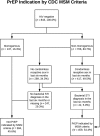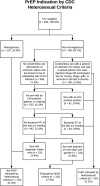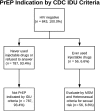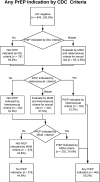High risk and low uptake of pre-exposure prophylaxis to prevent HIV acquisition in a national online sample of transgender men who have sex with men in the United States
- PMID: 31536171
- PMCID: PMC6752156
- DOI: 10.1002/jia2.25391
High risk and low uptake of pre-exposure prophylaxis to prevent HIV acquisition in a national online sample of transgender men who have sex with men in the United States
Abstract
Introduction: Trans masculine people who have sex with cisgender ("cis") men ("trans MSM") may be at-risk for HIV infection when they have cis MSM partners or share needles for hormone or recreational drug injection. Limited data are available characterizing indications and uptake of pre-exposure prophylaxis (PrEP) in trans MSM. The aim of this study was to assess PrEP indication and uptake as a means of primary HIV prevention for adult trans MSM in the U.S.
Methods: Between November and December 2017, a national convenience sample of trans MSM in the U.S. (n = 857) was recruited using participatory methodologies and completed an online survey of demographics, HIV risk, PrEP, behavioural and psychosocial factors. Self-reported receptive anal sex or frontal/vaginal sex (with or without a condom) with a cis male sex partner in past six months was an eligibility criterion. A multivariable logistic regression procedure was used to model PrEP indications (yes/no) per an interpretation of U.S. Centers of Disease Control and Prevention recommendations among those without HIV (n = 843).
Results: The diverse sample was 4.9% Black; 22.1% Latinx ethnicity; 28.4% non-binary gender identity; 32.6% gay-identified; 82.7% on testosterone. Overall, 84.1% had heard of PrEP. Of these, 33.3% reported lifetime PrEP use (21.8% current and 11.5% past). Based on HIV behavioural risk profiles in the last six months, 55.2% of respondents had indications for PrEP. In a multivariable model, factors associated with PrEP indication included where met sex partners, not having sex exclusively with cismen, higher perceived HIV risk, greater number of partners and high cis male partner stigma (all p < 0.05).
Discussion: The majority of trans MSM in this sample had a PrEP indication. Stigma was associated with risk for HIV acquisition and represents a critical target for HIV biobehavioural prevention interventions for trans MSM, who appear to be underutilizing PrEP.
Conclusions: Results from this study support the full inclusion of trans MSM in HIV biobehavioural prevention efforts. Public health interventions and programmes are needed to reach trans MSM that attend to general MSM risk factors as well as to vulnerabilities specific to trans MSM, including the context of stigma from cis male sexual partners.
Keywords: HIV; PrEP; men who have sex with men (MSM), sexual and gender minorities; social stigma; transgender persons.
© 2019 The Authors. Journal of the International AIDS Society published by John Wiley & Sons Ltd on behalf of the International AIDS Society.
Figures




Similar articles
-
The Pre-Exposure Prophylaxis Cascade in At-Risk Transgender Men Who Have Sex with Men in the United States.LGBT Health. 2021 Feb-Mar;8(2):116-124. doi: 10.1089/lgbt.2020.0232. Epub 2021 Feb 9. LGBT Health. 2021. PMID: 33567245 Free PMC article.
-
HIV burden and correlates of infection among transfeminine people and cisgender men who have sex with men in Nairobi, Kenya: an observational study.Lancet HIV. 2021 May;8(5):e274-e283. doi: 10.1016/S2352-3018(20)30310-6. Epub 2021 Feb 22. Lancet HIV. 2021. PMID: 33631101
-
Does HIV Pre-Exposure Prophylaxis Modify the Effect of Partnership Characteristics on Condom Use? A Cross-Sectional Study of Sexual Partnerships Among Men Who Have Sex with Men in San Francisco, California.AIDS Patient Care STDS. 2019 Apr;33(4):167-174. doi: 10.1089/apc.2018.0179. AIDS Patient Care STDS. 2019. PMID: 30932698 Free PMC article.
-
Demand creation and retention strategies for oral pre-exposure prophylaxis for HIV prevention among men who have sex with men and transgender women: a systematic review and meta-analysis.BMC Infect Dis. 2023 Nov 14;23(1):793. doi: 10.1186/s12879-023-08693-z. BMC Infect Dis. 2023. PMID: 37964202 Free PMC article.
-
The Use of Online Posts to Identify Barriers to and Facilitators of HIV Pre-exposure Prophylaxis (PrEP) Among Men Who Have Sex with Men: A Comparison to a Systematic Review of the Peer-Reviewed Literature.AIDS Behav. 2018 Apr;22(4):1080-1095. doi: 10.1007/s10461-017-2011-3. AIDS Behav. 2018. PMID: 29285638 Free PMC article.
Cited by
-
Pre-exposure prophylaxis among Brazilian men who have sex with men: a comparative study between migrants and non-migrants.Front Public Health. 2023 Aug 17;11:1198339. doi: 10.3389/fpubh.2023.1198339. eCollection 2023. Front Public Health. 2023. PMID: 37663850 Free PMC article.
-
Knowledge and Use of PEP and PrEP Among Key Populations Tested in Community Centers in Portugal.Front Public Health. 2021 Jul 23;9:673959. doi: 10.3389/fpubh.2021.673959. eCollection 2021. Front Public Health. 2021. PMID: 34368050 Free PMC article.
-
A Scoping Review of HIV Pre-exposure Prophylaxis Stigma and Implications for Stigma-Reduction Interventions for Men and Transwomen Who Have Sex with Men.AIDS Behav. 2021 Jul;25(7):2054-2070. doi: 10.1007/s10461-020-03135-2. Epub 2021 Jan 2. AIDS Behav. 2021. PMID: 33389319 Free PMC article.
-
Prevalence and Risk Factors of PrEP Use Stigma Among Adolescent Girls and Young Women in Johannesburg, South Africa and Mwanza, Tanzania Participating in the EMPOWER Trial.AIDS Behav. 2022 Dec;26(12):3950-3962. doi: 10.1007/s10461-022-03721-6. Epub 2022 Jul 1. AIDS Behav. 2022. PMID: 35776254 Free PMC article.
-
HIV prevalence among transmasculine individuals at a New York City Community Health Centre: a cross-sectional study.J Int AIDS Soc. 2022 Oct;25 Suppl 5(Suppl 5):e25981. doi: 10.1002/jia2.25981. J Int AIDS Soc. 2022. PMID: 36225145 Free PMC article.
References
-
- Centers for Disease Control and Prevention . HIV Surveillance Report. 29; 2017. [cited 2019 July 30]:[about 16 p.]. Available from: http://www.cdc.gov/hiv/library/reports/hiv-surveillance.html
-
- Rowniak S, Chesla C, Rose CD, Holzemer WL. Transmen: the HIV risk of gay identity. AIDS Educ Prev. 2011;23(6):508–20. - PubMed
-
- Baral SD, Poteat T, Strömdahl S, Wirtz AL, Guadamuz TE, Beyrer C. Worldwide burden of HIV in transgender women: a systematic review and meta‐analysis. Lancet Infect Dis. 2013;13(3):214–22. - PubMed
Publication types
MeSH terms
Substances
LinkOut - more resources
Full Text Sources
Medical
Miscellaneous

